Surely you will feel identified with the following situation, as it’s not unusual when you have Internet service at home. Once the contract is signed, the technician from the ISP comes to your house, locates the communications output, and installs the router just some meters away.
It is true that, on rare occasions, we can negotiate an installation on another room, but sometimes this is even not enough to ensure wireless access to all locations in the house. Though this lack of coverage in every corner was not a problem a few years ago, today most homes have a wide range of devices whose full functionality depends on a correct Internet connection; and not just entertainment or productivity elements (such as laptops, smartphones, tablets and printers), but also control and safety elements (such as wireless thermostats or surveillance cameras) that can only fulfill their functions if they have a stable Network connectivity.

To check if these problems have a solution, we reviewed one of the most powerful network extenders that can be found on the market, the TP-LINK WiFi Range Extender AC1750 RE450.
For big problems…
A big problem needs a big solution and the specifications of the TP-LINK WiFi Range Extender AC1750 RE450 show it as the perfect candidate for this issue.
In terms of design, it should be noted that its dimensions exceed those that we are accustomed to find in this type of devices. Its height is around 16 cm and reaches 20 cm at the time we deployed its antennas (we will talk more about this).
This is where we find the first two engineering details: first, the neutral design of the body of the AC1750 RE450, allowing us to install it in any room without breaking your decor; secondly, the carefully studied plug arrangement, which will only occupy an outlet, avoiding interruption in the use of other.
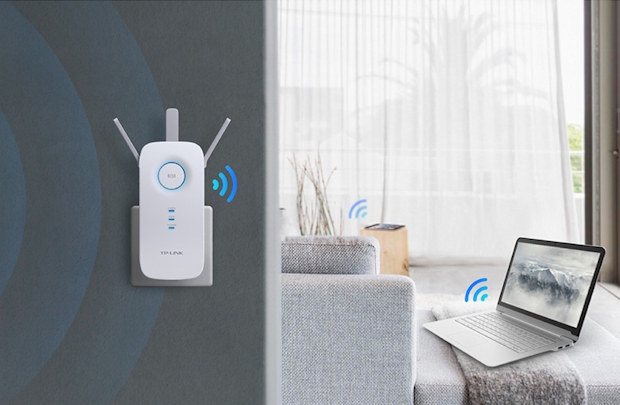
In the front part of the TP-LINK AC1750 RE450 you will find all the informative LED next to WPS connection button that this time is surrounded by a bright ring responsible for indicating both the connection status, as well as its quality, all through using a color code and intermittences.
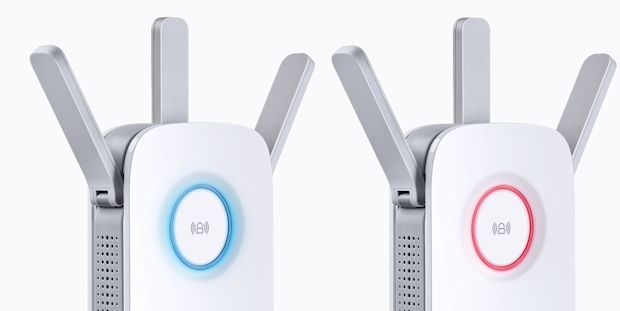
The side part has only the power and LED management buttons, and the RJ45 connection port, which have, just like the back cover, a perforated panel to facilitate the flow of air that prevents overheating of the device.
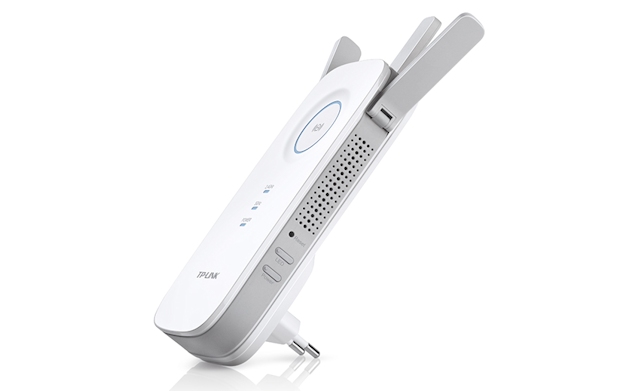
But without a doubt, the best feature of the TP-LINK AC1750 RE450 is the 3 external antennas that are at the top and sides, responsible for the outstanding performance offered by this TP-LINK range extender.
Avant-garde Tech
While Internet providers offer higher and higher bandwidths, technology developers upgrade their top end devices to squeeze the maximum out of them. That’s why the wireless chip of the TP-LINK AC1750 RE450 supports key IEEE 802.11 a/b/g/n/ac standards, which allows the indiscriminate (and combined) use of the 2.4 GHz and 5 GHz frequencies.
So, thanks to these TP-LINK AC1750 RE450 three directional antennas, it is possible to achieve the impressive transmission speed of 1,300 Mbps, only in the 5 GHz band, to which we should add the 450 Mbps 2.4 GHz for a combined rate of 1,750 Mbps.
It also provides a High Speed mode in which to maximize traffic data, one band is used for sending and the other for receiving.
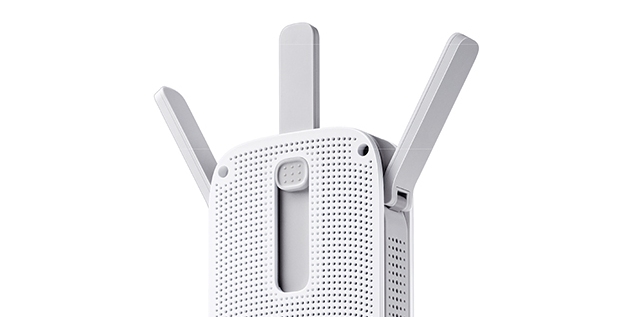
Now this power and speed require significant security features. Nobody wants that, by extending the coverage area (up to 930 m2, depending on the manufacturer), our neighbor or the business next door can access our WiFi network.
To prevent this from happening, the device itself provides us with a security configuration that includes 64 and 128 bit encryption for WEP, WPA-PSK and, of course, WPA2-PSK.
What if your computer doesn’t have WiFi?
Devices with wireless connectivity are currently the majority. But if you have a console, a desktop or SmartTV, statistics are useless, so we must provide solutions!
This is another key to predict the success of the TP-LINK RE450, its multifunctionality and ability to satisfy different profiles, both for its use and users.
Thus, those who for work or for any other reason are forced to use devices without WiFi connectivity, but need access to fast and stable Internet, can leverage on the practical Gigabit Ethernet (RJ45-10/100/1000) port to connect.
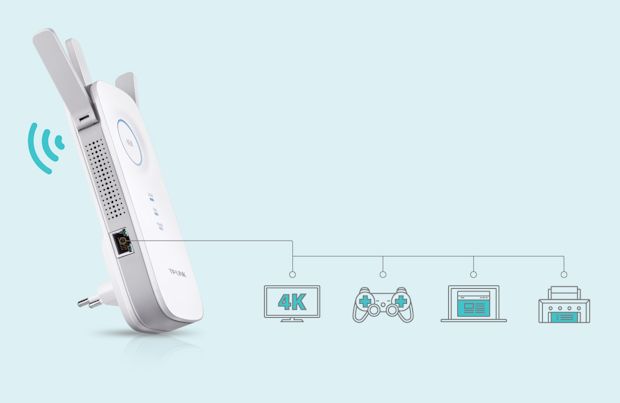
A Practical analysis
Let’s get on the practical level. We have made a real test with the TP-LINK Wi-Fi Range Extender AC1750 RE450 on a 100/10 Mbps connection with a 802.11ac Dual Band router and using a compatible mobile terminal with all the wireless standards.
But we also highlight the presence in the spectrum of more than 90 routers and access points transmitting and receiving data, and many other devices connected to these SSID. A complicated picture. But this is what we have found.
First, in a room away from the router about 15 m and several walls in between, we used free apps to measure signal strength and Ookla Speedtest app to measure the response time and the download and upload speeds.
In this scenario, without connecting the extender, the results under the 802.11n in the 2.4 GHz band were: -67 dBm and download and upload speeds of 13.97 Mbps and 8.99 Mbps, respectively.
The measurements under the 802.11ac standard in the 5 GHz band, resulted in -61 dBm and download and upload speeds of 90.32 Mbps and 10.52 Mbps respectively.
Then we put the TP-LINK WiFi Extender Range AC1750 RE450 out of the box, connected it to a wall near the router, we linked it using WPS (simply by pressing the RE button of the extender and the WPS in our router) and we located it within the home by using the color code mentioned above to find the optimal coverage place.
Connecting and Setting it up
The connection process is really simple. You just need to connect your device to the wireless network created by the range extender (You can identify it by the TP-LINK_Extender prefix), open a browser window and access the web settings page http://tplinkrepeater.net/, then login with the data you’ll find on the device itself.
At this point, let me emphasize that it is possible to change the name of the network created by the range extender and even hide the SSID.
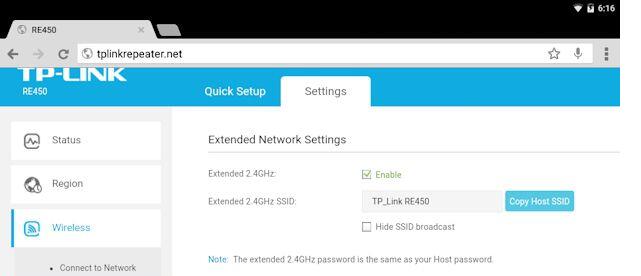
Now, let’s check the difference in coverage and speed offered by the router and the device. These were the results.
Again, we moved to the initial test location and performed new measurements to see if, indeed, the range extender field meets its promises.
The improvement in results was significant, mainly in the 2.4 GHz band. The measurements under the 802.11n standard in these frequencies had the following measurements: -58 dBm and download and upload speeds of 45.54 Mbps and 10.63 Mbps respectively, meaning that the download speed is tripled.
Making use of the 802.11ac standard in the 5 GHz band registered the following measurements: -61dBm and download and upload speeds of 102.15 Mbps and 10.75 Mbps, the maximum supported by the connection used.
It should be mentioned that throughout the analysis we also measured the average consumption of the TP-LINK Wi-Fi Range Extender AC1750 RE450 and though the brand manufacturer has it at 9W, we have never exceeded 5W, so the approximate cost of having the electric device connected throughout the year would not reach 6$.
Conclusion
The results speak for themselves. Using the TP-LINK WiFi Extender Range AC1750 RE450 can not only increase the coverage area of your Internet connection, mainly for devices that are not compatible with the 802.11ac standard in the 5 GHz band (the most used today), but we have also improved its stability in areas where navigation was impossible before.
So, in theory we have secured a fast LAN connection (up to 1,750 Mbps), secure and compliant with any router (either ADSL or optic fiber), and with any device that requires Internet connectivity wither through wired or wireless means.
In practice, you can leverage your Internet access limits to the maximum that the ISP gives you.
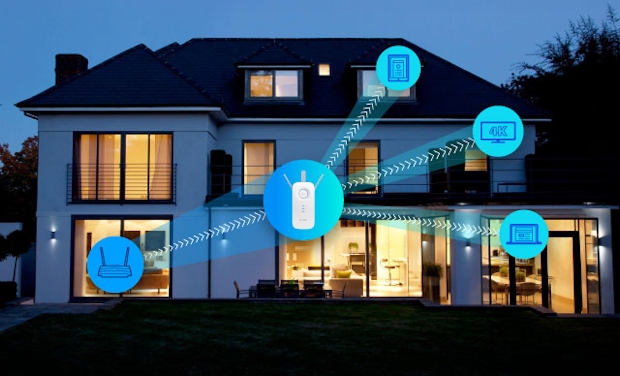
And finally, and getting pragmatic, we can’t ignore the economic factor. The electricity cost is minimal and taking each month as reference, we often stop taking advantage of a minimum of 10% of our connection because of network problems (5€ wasted), but as you can recover it and make the most of all bandwidth in every corner, the TP-LINK AC1750 RE450 is a very advisable investment.